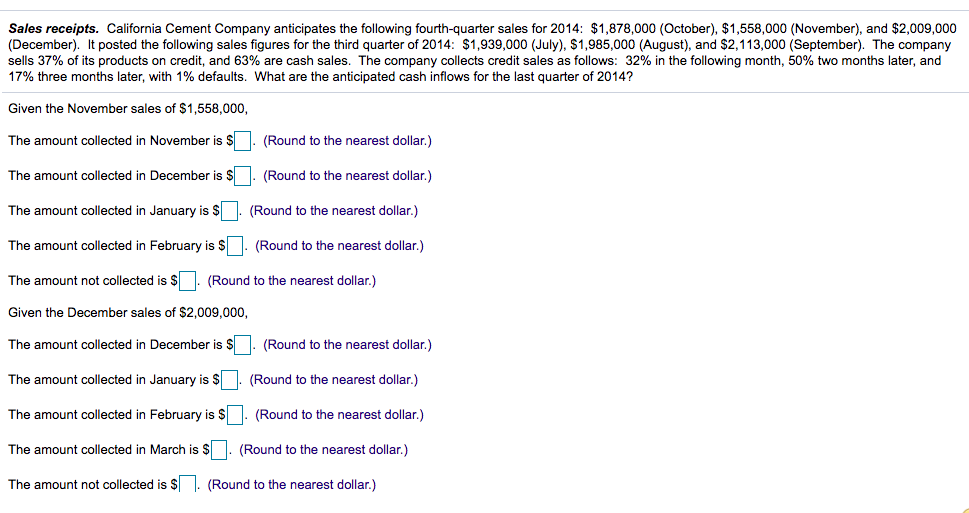Sales receipts. California Cement Company anticipates the following fourth-quarter sales for 2014: $1,878,000 (October), $1,558,000 (November), and $2,009,000 (December). It posted the following sales figures for the third quarter of 2014: $1,939,000 (July), $1,985,000 (August), and $2,113,000 (September). The company sells 37% of its products on credit, and 63% are cash sales. The company collects credit sales as follows: 32% in the following month, 50% two months later, and 17% three months later, with 1% defaults. What are the anticipated cash inflows for the last quarter of 2014? Given the November sales of $1,558,000, The amount collected in November is $: (Round to the nearest dollar.) The amount collected in December is S (Round to the nearest dollar.) The amount collected in January is $| (Round to the nearest dollar.) The amount collected in February is $]. (Round to the nearest dollar.) The amount not collected is S (Round to the nearest dollar.) Given the December sales of $2,009,000, The amount collected in December is $. (Round to the nearest dollar.) The amount collected in January is $[ (Round to the nearest dollar.) The amount collected in February is S. (Round to the nearest dollar.) The amount collected in March is $]. (Round to the nearest dollar.) The amount not collected is S ]. (Round to the nearest dollar.)
Sales receipts. California Cement Company anticipates the following fourth-quarter sales for 2014: $1,878,000 (October), $1,558,000 (November), and $2,009,000 (December). It posted the following sales figures for the third quarter of 2014: $1,939,000 (July), $1,985,000 (August), and $2,113,000 (September). The company sells 37% of its products on credit, and 63% are cash sales. The company collects credit sales as follows: 32% in the following month, 50% two months later, and 17% three months later, with 1% defaults. What are the anticipated cash inflows for the last quarter of 2014? Given the November sales of $1,558,000, The amount collected in November is $: (Round to the nearest dollar.) The amount collected in December is S (Round to the nearest dollar.) The amount collected in January is $| (Round to the nearest dollar.) The amount collected in February is $]. (Round to the nearest dollar.) The amount not collected is S (Round to the nearest dollar.) Given the December sales of $2,009,000, The amount collected in December is $. (Round to the nearest dollar.) The amount collected in January is $[ (Round to the nearest dollar.) The amount collected in February is S. (Round to the nearest dollar.) The amount collected in March is $]. (Round to the nearest dollar.) The amount not collected is S ]. (Round to the nearest dollar.)
Excel Applications for Accounting Principles
4th Edition
ISBN:9781111581565
Author:Gaylord N. Smith
Publisher:Gaylord N. Smith
ChapterMB: Model-building Problems
Section: Chapter Questions
Problem 22M
Related questions
Question
Question 2

Transcribed Image Text:Sales receipts. California Cement Company anticipates the following fourth-quarter sales for 2014: $1,878,000 (October), $1,558,000 (November), and $2,009,000
(December). It posted the following sales figures for the third quarter of 2014: $1,939,000 (July), $1,985,000 (August), and $2,113,000 (September). The company
sells 37% of its products on credit, and 63% are cash sales. The company collects credit sales as follows: 32% in the following month, 50% two months later, and
17% three months later, with 1% defaults. What are the anticipated cash inflows for the last quarter of 2014?
Given the November sales of $1,558,000,
The amount collected in November is s
(Round to the nearest dollar.)
The amount collected in December is $
(Round to the nearest dollar.)
The amount collected in January is $. (Round to the nearest dollar.)
The amount collected in February is $. (Round to the nearest dollar.)
The amount not collected is $ . (Round to the nearest dollar.)
Given the December sales of $2,009,000,
The amount collected in December is $
(Round to the nearest dollar.)
The amount collected in January is $. (Round to the nearest dollar.)
The amount collected in February is $. (Round to the nearest dollar.)
The amount collected in March is $. (Round to the nearest dollar.)
The amount not collected is $ . (Round to the nearest dollar.)
Expert Solution
This question has been solved!
Explore an expertly crafted, step-by-step solution for a thorough understanding of key concepts.
This is a popular solution!
Trending now
This is a popular solution!
Step by step
Solved in 5 steps with 1 images

Knowledge Booster
Learn more about
Need a deep-dive on the concept behind this application? Look no further. Learn more about this topic, accounting and related others by exploring similar questions and additional content below.Recommended textbooks for you

Excel Applications for Accounting Principles
Accounting
ISBN:
9781111581565
Author:
Gaylord N. Smith
Publisher:
Cengage Learning

Principles of Accounting Volume 2
Accounting
ISBN:
9781947172609
Author:
OpenStax
Publisher:
OpenStax College

Excel Applications for Accounting Principles
Accounting
ISBN:
9781111581565
Author:
Gaylord N. Smith
Publisher:
Cengage Learning

Principles of Accounting Volume 2
Accounting
ISBN:
9781947172609
Author:
OpenStax
Publisher:
OpenStax College